This fermented honey garlic is the perfect thing to make to boost your immune system! Both honey and garlic have strong medicinal benefits, so you’ll want to have this delicious home remedy on hand for cold and flu season.
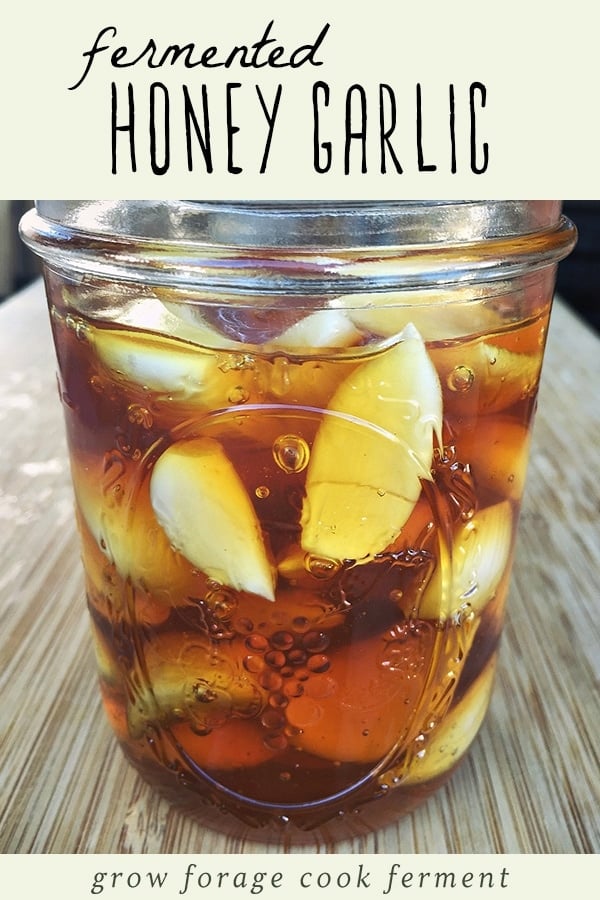
Want to save this post for later?
Fermenting Garlic in Honey
I’m really excited to share this post with you! Fermented honey garlic is something I’ve been wanting to try for a very long time, ever since I first read about it on the Killer Pickles blog.
I usually reserve my honey for mead making, but using it for other ferments intrigued me. Don’t ask me why I haven’t done it until now, because it’s the easiest thing in the world!
This tasty fermented garlic in honey can be used for many things, as good food and good medicine. Honestly though, I like to just eat it as is!
Fermented Honey Garlic Recipe
Making fermented honey garlic is so easy, it hardly needs a recipe!
Prepare the Garlic
The hardest and most time consuming part is prepping all of the garlic. Whatever size jar you use, you’ll want to fill it about 1/2-3/4 full of peeled garlic.
The quickest and easiest way to prep garlic is to place the side of a chef’s knife on top of a single clove and then give it a firm whack with the palm of your hand.
Don’t do it too hard, as you don’t want to crush the garlic, but just enough to lightly bruise the it. This will make it easy to peel, and will also release a bit of the garlic juice.
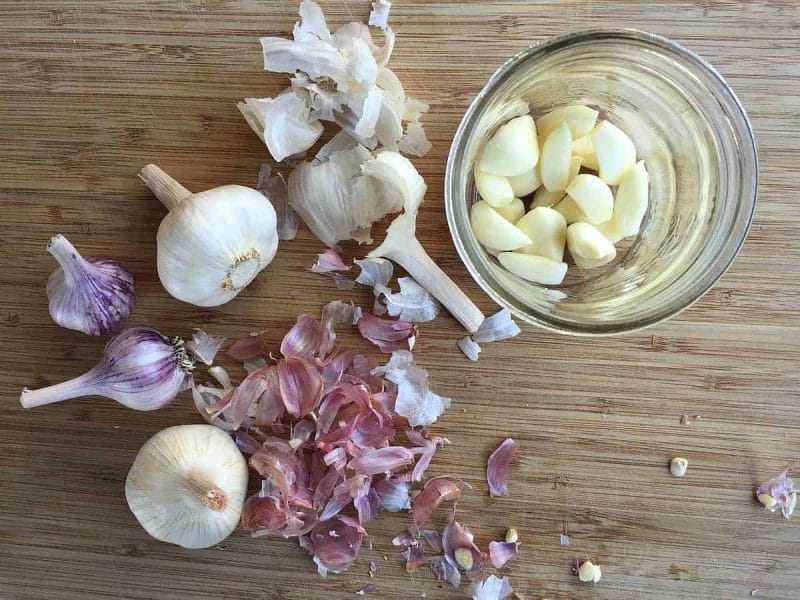
Add the Honey
Once you have enough garlic in your jar, pour in some raw honey to cover it. The garlic will probably float a bit and that’s ok.
It’s important to use raw honey to make fermented garlic in honey, as it will still have all the bacteria and wild yeast that is necessary for fermentation.
When liquid is added to honey, it jump starts the fermentation process. The small amount of juice from the garlic will create just enough liquid for fermentation to happen.
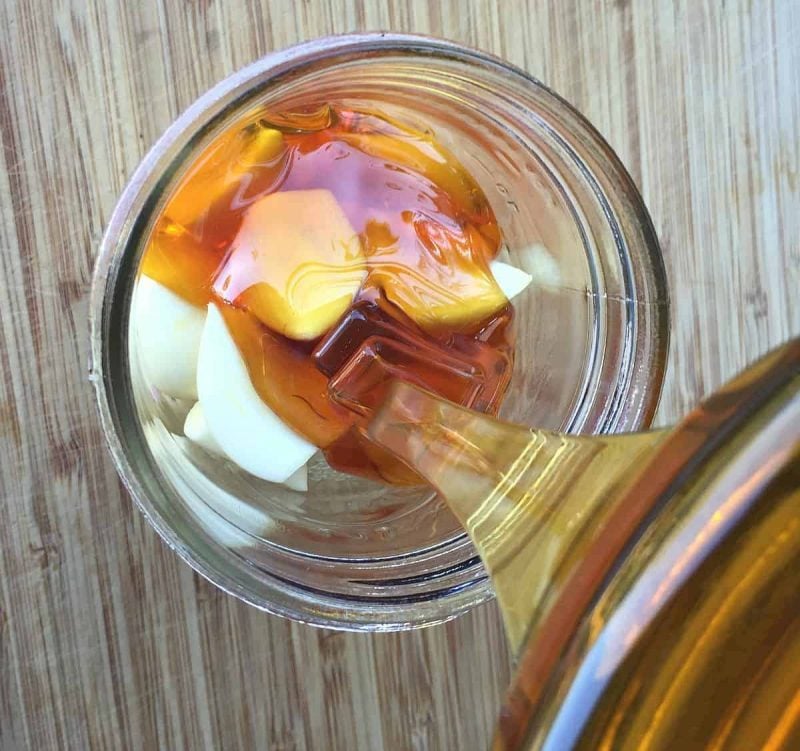
Cover and Flip
Cover the jar loosely with a lid to let the gasses escape, and put it in a dark place to ferment.
It’s a good idea to put a plate or something similar underneath the jar as it’s fermenting, as it will likely bubble up a bit and a little honey could possibly drip out.
It’s also important to gently turn the jar over every day or so, or whenever you think about it, to make sure that all of the garlic stay coated with honey.
Screw the lid on tightly before you do this! Then return it to it’s upright position and re-loosen the lid.
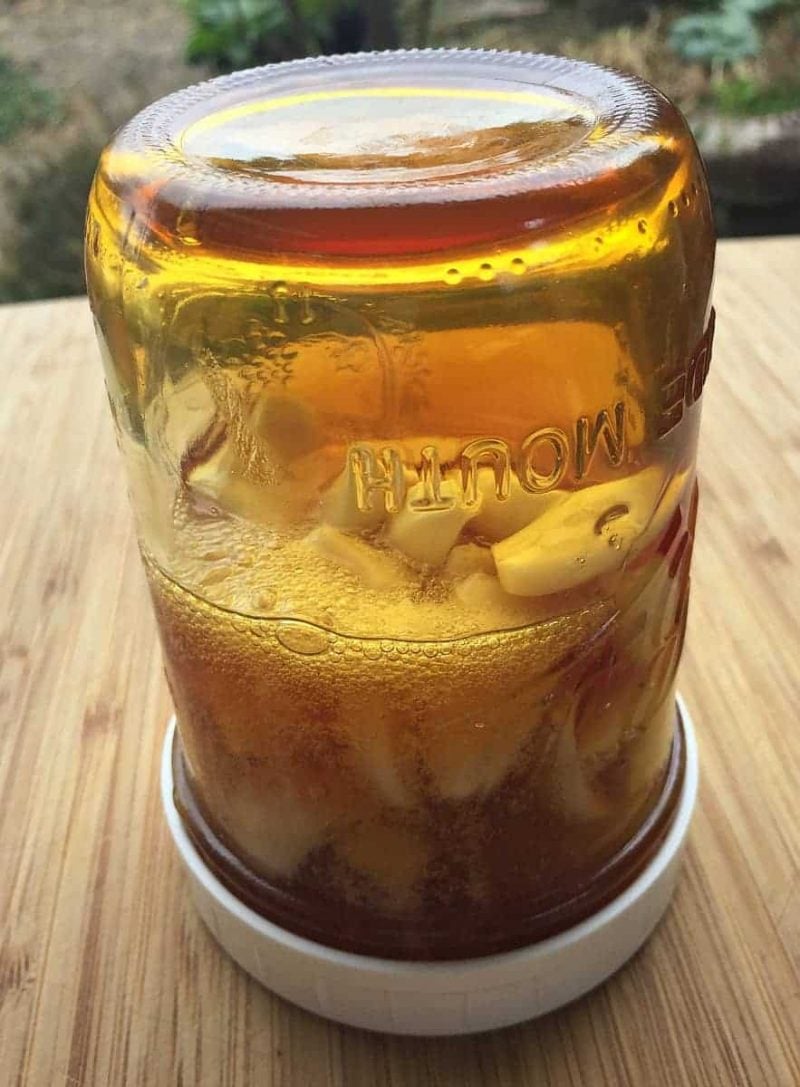
In a few days to a week you will notice some bubbles forming on the surface of the honey. Hooray!
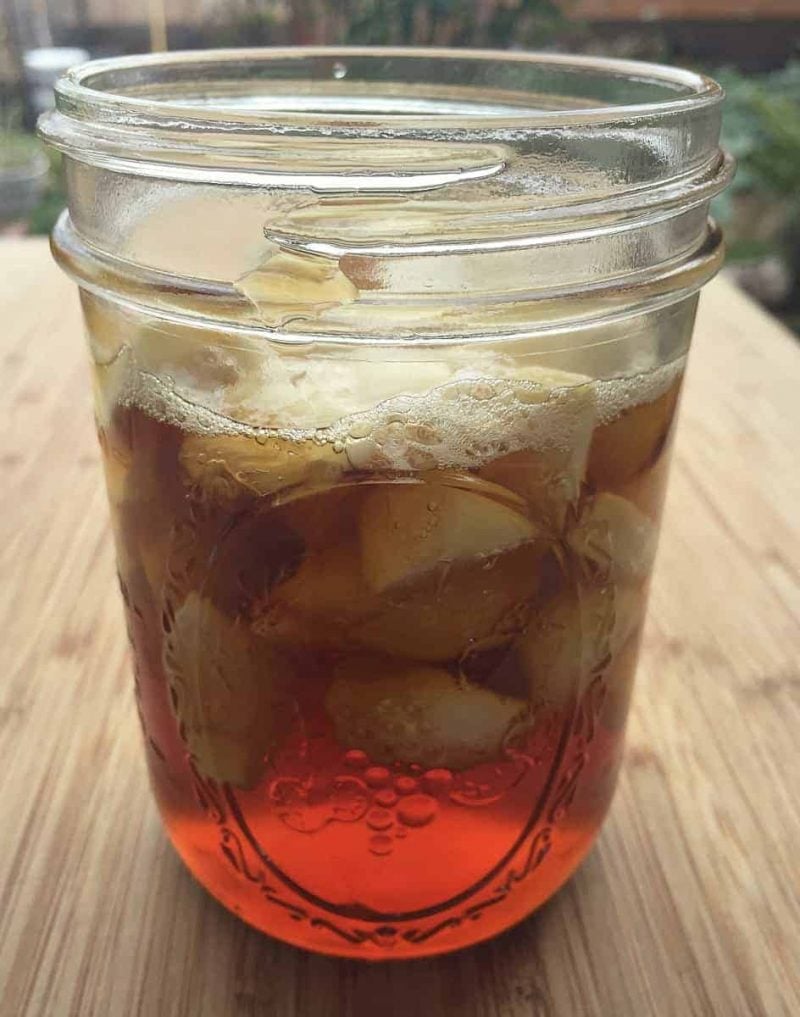
The honey garlic will ferment for about a month, but you can eat it at any time during the process.
The flavor will continue to develop over time, the garlic will mellow, and the honey will become much runnier.
Occasionally the garlic cloves turn a blue or green color due to a reaction during the fermentation process. While it may be a bit alarming, it is not harmful and the honey garlic can still be used.
Honey garlic will store well in a cool place for many months, or even a year or longer! I’ve kept some for over two years and it is still good.
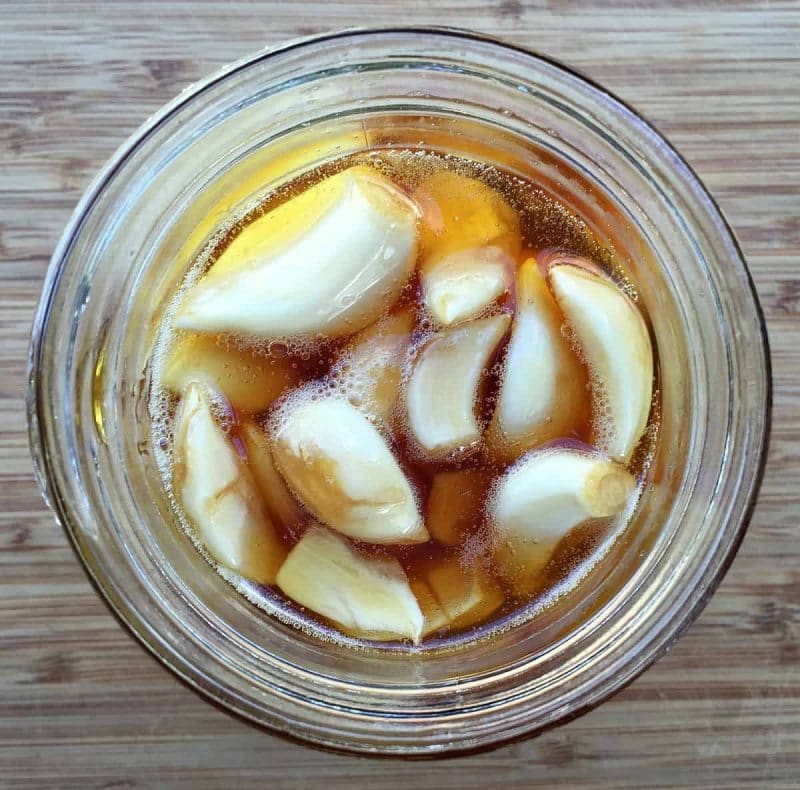
Using Fermented Honey Garlic
Now, how do you use this fermented honey garlic? That’s a good question, and it can be used in a variety of ways.
Both garlic and honey have strong medicinal properties, so it makes sense to use it as an immune booster or if you feel a cold or flu coming on.
Pop a whole garlic clove, or take a spoonful of honey (or both!).
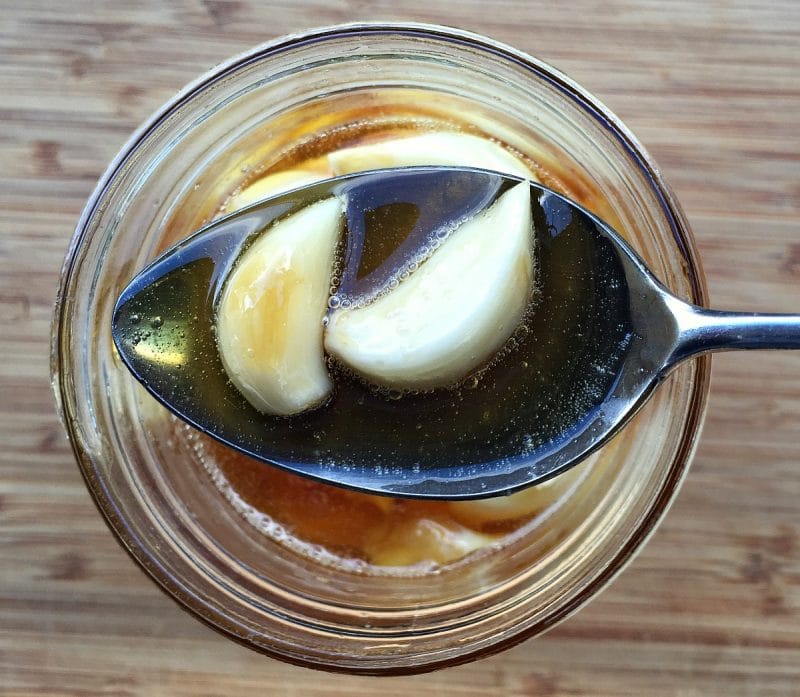
As you can probably imagine, honey garlic also makes a wonderful food!
It’s a natural in marinades and sauces, and would make a really tasty glaze for meats or veggies. Basically anything where you would normally use honey and garlic together!
Is Botulism a Concern in Honey Garlic?
I get this question a lot about fermented honey garlic! The short answer is no, botulism is really not a concern in this type of ferment.
While botulism can happen in garlic and oil preparations without added acidity, the fermentation process that happens here makes it very unlikely.
Raw honey is acidic, and while it can carry botulism spores (which is why it is not recommended for babies under 1 year), the level of acidity stops them from reproducing, which is what causes botulism.
If you are concerned about it, use a pH test strip. Botulism spores can’t reproduce with a pH of less than 4.6. Honey is usually around 3.9, but that can vary between brands.
If the pH is too high, add a splash of raw apple cider vinegar to add more acidity and retest. This is generally not needed, but I did want to mention it.
Honey garlic should not be given to babies under one year of age.
I really hope you make this yummy honeyed garlic! It’s super easy, and great to have on hand. I have a feeling it’s going to become a staple in our house!
Have you ever made fermented honey garlic? How do you use it?
More Fermented and Infused Honey Recipes
Enjoy these other recipes that showcase fermented and infused honey!
- Fermented Honey Cranberries
- Fermented Elderberry Honey
- Herbal Infused Honey
- Lilac Flower Infused Honey
Fermented Honey Garlic
Equipment
Ingredients
- 1 cup whole garlic cloves peeled and slightly crushed
- 1 cup raw honey or more, as needed to cover garlic
Instructions
- Place the peeled garlic cloves into a wide-mouth pint sized mason jar. Add enough honey to completely cover the garlic cloves. Make sure they are coated with honey.
- Place the lid on the jar loosely, then tuck into a dark place.
- Every day or so, tighten the lid on the jar and flip it upside down to coat the garlic cloves with honey. Loosen the lid again when you return it to the upright position.
- Within a few days to a week, you should see small bubbles start to form on the surface of the honey.
- The honey garlic will ferment for about a month, but you can eat it at any time. The flavor will continue to develop over time, the garlic will mellow, and the honey will become much runnier.
- Store in a cool place for many months or even a year, if not longer.
Notes
- It’s important to use raw honey for this recipe, as it has all of the bacteria and wild yeast that is necessary for fermentation.
- The small amount of juice from the garlic will create just enough liquid for fermentation to happen.
- It’s a good idea to put a plate underneath the jar during fermentation, as it will likely bubble up and a little bit of honey could possibly drip out.
- Occasionally the garlic cloves turn a bluish or greenish color during the fermentation process. While it may be a bit alarming, it is not harmful and the honey garlic can still be used.
- If you are concerned about botulism, use a pH test strip. Botulism spores can't reproduce with a pH of less than 4.6. Honey is usually around 3.9, but that can vary between brands.
- If the pH is too high, add a splash of raw apple cider vinegar to add more acidity and retest. This is generally not needed, but I do want to mention it.
- Honey garlic should not be given to babies under one year of age.

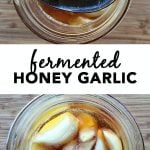
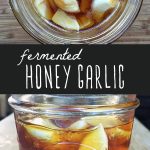
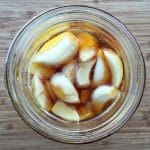

Hi
I have a question as well.
I followed your recipe but my raw honey is very thick and therefor almost not runny.
Flipping the jar upside barely doesn’t do anything. Will the honey become more fluid during the fermentation process ?
Also after one day I opened the jar and went through it with a wooden spoon bcs not all the garlic on the bottom was covered with honey since the honey is so thick. I hope I didn’t do wrong by that…
Have you tried moving it to a warmer location? You could also try putting the jar in half way submerged in a bowl of warm, not hot, water until the honey liquifies.
Hey I’m a newbie and making my first patch this weekend. About how loose should the lid be? Like sitting on the or relatively screwed on? Also do I need to check the ph levels or whatever to make sure the acidic levels are right ?
Hi Sabrina. It can be sitting on top or slightly screwed on. It just needs to release built up gases. You can definitely check the pH, if you want!
I put my crockpot too close to the jars, and when I moved them they were warm to the touch. Should I throw this batch out or test them first? Or are they fine?
Hi Ryan. It’s really hard for me say because I don’t know hot the honey got. It’s most likely fine, though.
Hello- question for you please: my first time making honey fermented garlic and I did flip the jar daily and burp it as well. I had vigorous bubbling for about a week and then it slowed down as expected. I bought ph test strips and tried to test the liquid honey from the jar but the color on the strip didn’t really change, which looked to me like a 6-ish ph, which was very confusing to me. I tested vinegar and water on the strips to make sure they were working and they were…. I wondered if the thicker texture of the honey altered the reading. Any thoughts on this? Thanks so much! I’m very eager to try them- it’s been almost 2 months at this point. When I tested, it was early on, I think in the first few days.
Just made my first jar, great way to use u some of my homegrown garlic. Thinking of adding fresh ginger for an extra health and taste kick. Thank you so much for sharing your knowledge and recipe.
I had a question. I went to make mine and I kept my jar closed without Breathing, Is that an issue when I finally opened it it let out all the gas, but I didn’t know if it’s still good?
As long as it smells good and there isn’t mold, it is fine.
Hi Colleen,
I just tried the fermented garlic in honey and it is DEEEELISH!!!!
I have been eating a clove a day and I love how the honey has softened the pungency of the garlic.
I am very excited to use the garlic honey in recipes or just to enjoy it straight out of the jar with a spoon!!!
And as always Colleen, thank you ever so much for sharing your knowledge.
Leona
You are so welcome. Enjoy!!
I wish I had found your recipe before I put my garlic and honey in the jars.
I did not use raw honey.
Will it still ferment?
Most likely not, but that’s okay, you’ll still have garlic infused honey, which is almost just as good.
Can you use manuka honey in this recipe? What’s the lowest mgo (or umf) number (or rating) to use?
Thank you
Hi Philip. Sure, you can use it as long as it’s raw and never treated. I’m not sure what the lowest number is to use.
I’ve seen recipes with red onion and raw honey, would that work the same/similar?
Yup! I have a recipe with those ingredients in my book, Healing Herbal Infusions. It’s delicious.
I made some like, last year and used all the garlic. should I throw out the honey. Honey stays good forever right?
The honey is still perfectly fine!
Is it fine to chop the garlic before fermenting as opposed to keeping cloves whole? I’ve looked at a few websites and haven’t seen anyone chopping it, but I would much rather chop it BEFORE it’s coated in honey than after, and my kids probably wouldn’t eat a whole clove. :/
Yup, totally fine to chop it!
Hi, do I need to sterilize the brand new Quattro Straggioni jar with lid that I bought? I do not own canning tools and am a newbie? Thanks!
I would wash it well with hot, soapy water.
Will the garlic cloves float to the top?
They may or may not. I cover this in the recipe instructions. You will need to flip the jar daily to prevent the garlic from being exposed to air during the fermentation process.
May I ask, how long should it “bubble”? Ours bubbled for a few days and then no more. It’s been over four weeks and is simply syrupy. Is this accurate? And if so, do we leave it out for storage or move to the fridge? :)
If the bubbles stop, it’s safe to assume fermentation is complete, and you can store your fermented honey in your pantry or kitchen cabinet with the lid closed.
Can this be stored in the refrigerator after the bubbles stop?
It shouldn’t be refrigerated. Store in a cool, dark kitchen cabinet or pantry shelf.
Hi Colleen
Yet another yummy recipe I can hardly wait to try!!!
I have an oxymel from your Healing Herbal Infusions on the go, so the fermented garlic in honey will be a nice addition to my repertoire😊
Thank you so much for all your knowledge that you so graciously share.
Leona
You are so welcome, Leona! Enjoy!
Is organic ingredients recommended? I don’t have access local honey. Would raw local honey from Trader Joe’s be ok to use? It comes in a glass bottle and is labeled “bottled at Highland Valley in Milford PA” From rural areas of pa, ny, and nj.
Hi Marybeth. Organic garlic is recommended. Any raw honey will do!
Hello – do you swallow the Clove whole or do you crunch it?
I chew it.
Hi! I just started the process yesterday and it stinks to my hubby, lol. Can I keep the cab with a slightly open lid in the garage? It’s pretty cool there. We are in Canada. Thanks!
It needs to be fairly warm, no less than 65℉.
So I used your instructions, and according to a friend, made the most fabulous cheese topping she’d ever tasted!
My question is, I made my 2nd batch (after my 1st had mysteriously disappeared, see above!) with allotment freshly harvested but then frozen cloves. I didn’t defrost them, just placed them in a jar and added my raw honey. I didn’t see the same bubbling as I did with the 1st, when I’d used fresh. Is it safe to use frozen cloves? If I test and it’s below 4.6, can I assume it’s safe? Thank you.
Hi Paula. I’ve never used frozen cloves before, so I can’t say for sure. I would test the pH see where it’s at. It could be that fermentation started off a little sluggish because of the cold cloves and may need more time somewhere warm to really kick off.
How do you keep the garlic coated? Mine just float to the top
By flipping the jar daily. The garlic will be fine, even if it floats to the top as long as it has a thin coating of honey on it.
Does this produce any alcohol? I’m sober and I want to make this but I don’t want to ingest alcohol unless it’s very small amounts. Less than 1% would be ok
Very, very little alcohol is produced, if any.
Do you have to crush the garlic?
No, but you can if you want.
Once you’ve eaten all the honey, can you recover the garlic with honey and make another batch?
It’s best to always start another batch to prevent cross contamination.
The other way to peel a bunch of garlic cloves is to place them in a bowl, add another bowl the same size on top and shake vigorously. When you remove the top bowl most of the cloves will be very easy to peel.
Great tip!
i saw your blog in digital marketing trends, Great blog very effective homeopathy .keep writing more.
Should I take the honey out after a month? What dosage do you recommend? First time making it 😁
I don’t ever strain the honey out. Once the bubbles stop coming to the surface, it’s done fermenting and safe to close the lid. It’s food, so you can eat as much as you want!
Below the recipe you stated “If you are concerned about botulism, use a pH test strip. Botulism spores can’t reproduce with a pH of less than 4.6. Honey is usually around 3.9, but that can vary between brands.”
In the question above you stated “As long as the pH is higher than 4.6, botulinum can’t grow, so it sounds like your garlic ferment is fine!”
According to the USDA your first response was correct.
Nice catch. It was just a brain fart and I corrected the previous comment.
My garlic is a little soft and some has started to sprout. I took out the least sprouted pieces. Can I use those or does the garlic need to be very firm?
I would not use sprouted garlic. You want to use the freshest possible garlic so that there’s enough moisture to ferment the honey.
We made this, set it aside for a few months and im not sure it’s ever been turned to keep the floaters coated. Is it safe?
It should be fine as long as there’s no mold and doesn’t smell off. If you’re worried, add some apple cider vinegar to bring down the pH.
Hi, I managed to find some raw local honey so started a batch probably a couple of months ago. I’ve never seen any bubbles though the honey is more runny and the garlic is shrinking a bit. I’ve just tested the pH and it looks to be about 5 or 6, is this safe? I’m wondering if I put too much garlic to honey
Hi Karen. As long as the pH is lower than 4.6, botulinum can’t grow, so it sounds like your garlic ferment is fine!
I’m confused, because above you say it should be less than 4.6 and is usually around 3.9. Should the PH be higher or lower than 4.6 to avoid botulism?
Lower! The previous comment was a brain fart.
correct your ph is too high, add ACV and get it below 4.6
Does this mean that ACV can kill any botulism that has already formed? Please advise, I’m thinking of adding some to all my ferments as a just in case. Thank you!!
Botulinum doesn’t grow in environments that are acidic, so adding ACV to your honey ferment lowers the pH, (makes it more acidic) but it does not destroy botulinum that has already formed.